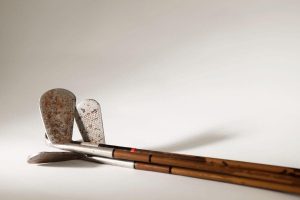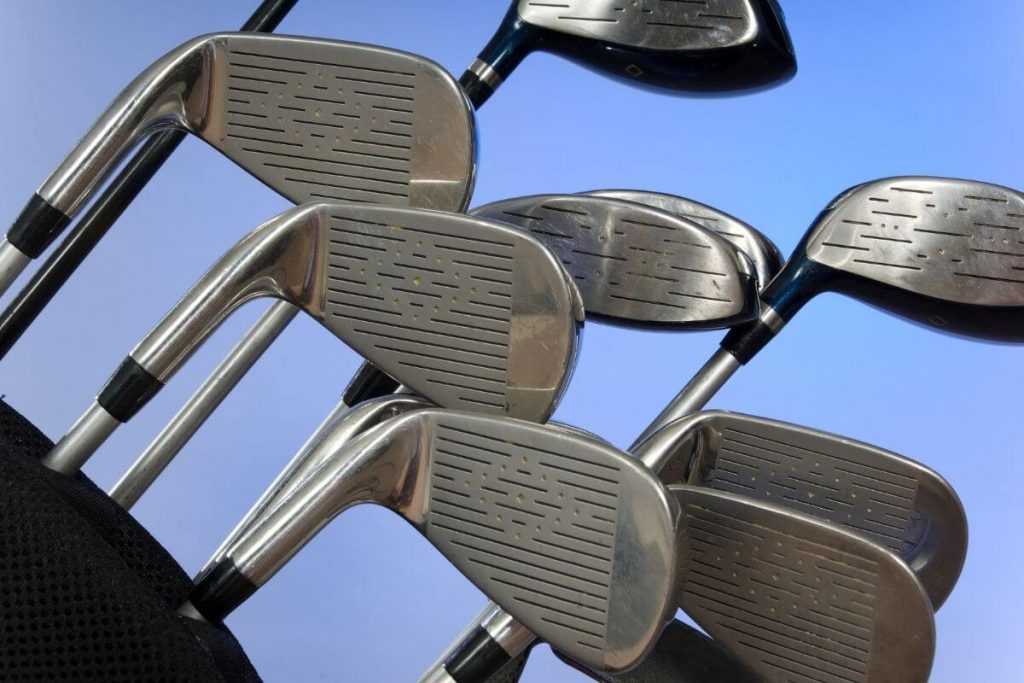Your golf clubs should be kept in a good condition so that they can perform at their full potential. Some golf clubs that you buy will be made from steel, titanium, graphite or other types of metals. This begs the question, Can golf clubs rust?
Table of Contents
Can Golf Clubs Rust?
Since steel is a mixture of iron and carbon, your steel golf clubs can rust with time. However, golf clubs made from titanium are resistant to rusting, incredibly durable and are long lasting.
Keeping your golf clubs clean will reduce the amount of time it takes to rust. Leaving your clubs in moist environments whether in the form of dew, rain or condensation will significantly affect rusting.
Therefore, it’s best to store your clubs in a temperature controlled environment that is warm and dry. An ideal place is a closet area inside your home.
Nevertheless, many manufacturers are now making golf clubs out of stainless steel. As you may know, this type of material is highly resistant to corrosion or rust.
Stainless steel is a steel alloy that contains at least 10.5% of chromium content. It is this chromium that reacts with the oxygen in the air to form a protective layer that significantly reduces rusting.
Image showing rusty golf clubs

How To Prevent Your Clubs From Rusting
There is a saying that says prevention is better than cure as getting rid of rust from your clubs can be a tough task to perform. Therefore, It’s important to take the necessary precautions that will prevent your clubs from rusting. These include:
- Drying Your Clubs With a Towel after using them
- Storing your clubs properly
- Cleaning your clubs
Neglecting your clubs will allow rust to eat away at them and their grooves most importantly. The grooves of your clubs play a critical role in the spin of the golf ball. A rusted golf club such as a wedge will spin less. It is the spin that helps to generate lift and influence how high the ball flies and how quickly it stops before landing.
1. Dry Your Golf Club With Towel
Whenever you play a round of golf, your clubs can get moist or wet during play, especially if you are playing in the rain or on dew covered course. And as we’ve mentioned before, rust is more likely to occur in damp or moist conditions.
One way you can avoid this is by drying the head and shaft of your golf club after using them. You can do this with your golf towel.
There are many purposes of a golf towel, but the main purpose is to clean and dry your clubs, as well as the grips, balls, gloves and also your hands.
These kind of towels are designed to absorb moisture from golf clubs and sweaty hands. Therefore, using a golf towel to dry your golf clubs will help reduce the risk of rust building.
After drying your golf equipment, you should hang the towel on a ring near the top of your golf bag to dry.
2. Store Your Clubs Properly
Storing your clubs in the right area is just as important as wiping them off. Since we know that moisture increases the risk of rusting, you would want to store your clubs in an area that is not humid.
Warm and dry environments like a closet area in your home is a great place to store them. On the other hand, your basement or garage is not a suitable place because they are not temperature controlled. These places can easily get cold during the winter.
Another place that you should not store your clubs is in the trunk of the car as too much heat from the vehicle can damage the shaft.
3. Clean Your Clubs
Neglecting your clubs can cause dirt and debris to build up. So what is the relationship between dirt and rust? Well, rust can be made worse by dirt in the following way:
When dirt builds up on the club head and shaft, it acts like a sponge. The dirt absorbs water and increases the chance of rusting. Hence, you want to get rid of any dirt, debris, or grime that resides on the surface of your club head or shaft.
Cleaning the parts of your club is a simple task that you can perform at the comfort of your home. Here is what you will need:
- Warm water
- Towel
- Bucket
- Steel polish
- Cloth
- Dishwashing liquid or soap
- Old Soft toothbrush
Related Post: Can golf balls be soaked in bleach
How To Clean Your Golf Club Head
- Fill a bucket with warm water. You don’t want the water to be hot enough to loosen the epoxy glue that joins the head to the shaft.
- Add dishwashing liquid to the bucket of water.
- Place the golf club such that the club head is fully immersed in the bucket of soap water. Let it soak for 5 to 10 minutes so that any stubborn dirt, stains or grime can loosen and be easily removed. If your clubs are extremely dirty with mud you can leave them in the bucket for a longer period.
- Take your club heads out of the soapy water, and use a soft toothbrush to scrub away any remaining dirt. Make sure to scrub in between the grooves as well as scrub the back, front and bottom of the club head. Neglecting these areas can allow the dirt to remain on the surface thus facilitating rusting. Dirty grooves can also negatively impact your game.
- Run the club heads under water and dry them off thoroughly with a towel. Leaving them damp can cause them to rust.
- To make your club head look good, apply chrome or steel polish and rub gently in circular motions.
- Once completed, remove all the polish and ensure no grease is left on the club head.
How To Clean The Shaft And Grips
Cleaning the shaft is equally important as cleaning your club head. You can simply use a damp cloth to clean off any grime from the shaft then dry thoroughly with a towel.
The grips can also easily get dirty and worn from sweat. Because you hold the end of the club so often, you should clean it regularly, for example, after each time you play.
To clean the grips, get a damp cloth and wipe it over the surface. Rinse with water and dry using a towel. Your grips may however need a deeper clean if it is too dirty. In that case, use a dish soap and a soft-bristled brush to scrub standard wraps.
You can even use rubbing alcohol to wipe it clean which is great if you have a rubber handle or porous grip. Keeping you club grips in a good condition will ensure you have the best grip on your game thereby allowing you to maintain control of the golf club.
How To Remove Rust From Off Your Golf Club
Now that we’ve gone through the precautions to prevent rusting from occurring, we are going to look at what to do if you end up with a rusted golf club. You shouldn’t have a problem with rusting if you maintain your clubs in good condition. But there are situations out of our control that may cause this to occur, time being the main factor.
Regular soap and water will be very difficult to remove rust from your shafts or head, and in some cases impossible. Here are 3 effective ways of removing rust from your golf club:
1. Remove Rust With Citric Acid
Citric acid works like a charm in removing rust from iron. Add 3 table spoons of citric acid to a bowl of warm water and submerge your rust club head or shaft overnight.
The next day scrub off the freshly dissolved rust. The drawback to using citric acid is that it may remove any painting or coating on your golf club causing discoloration. You can get citric acid at your supermarkets or health food stores.
2. Remove Rust With White Vinegar
Vinegar is great for removing stubborn rust and it does not cause discoloration unlike the citric acid. Vinegar is a common household product that yo can get at your local supermarket.
It contains acetic acid that is acidic enough to dissolve rust. To remove rust from club head using vinegar, submerge your club head in a bowl of vinegar and let is soak overnight.
In the morning, the club head from the bowl and scrub the rust off using a wire brush. If there are some parts still rusted, repeat the process and soak the club head longer.
Once all the rust is removed, clean with dish soap and water.
Dry thoroughly with towel.
2. Remove Rust With Baking Soda
Baking soda is ideal for clubs with a lighter rust stain as it isn’t that much acidic to remove extremely stubborn stains. Create a paste of baking soda and water in a bowl, and coat the paste all over the club head or shaft.
Make sure the rust spots are well covered with the paste. Let the paste sit for about a hour or two. Use a wire brush to scour the irons. Rinse the paste off with water and dry the club properly with a towel.



